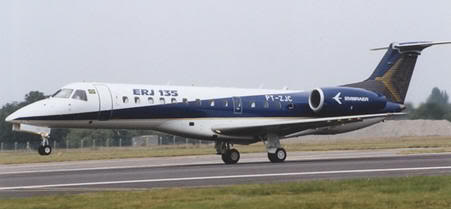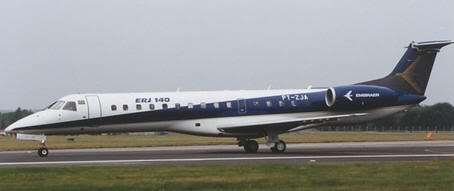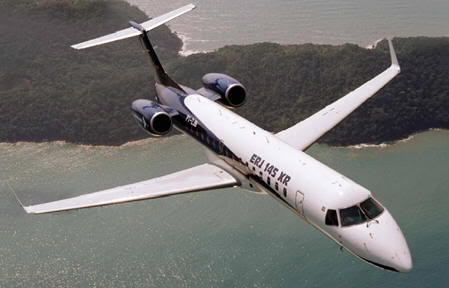
|
|
Embraer ERJ-135
ERJ-135 is the smallest jet of the ERJ family (Embraer Regional Jet).
The ERJ 135 is based on ERJ-145 and was launched in September 1997. It fuselage
is 3.6 meters shorter than the ERJ145 and has 98% of commonality,
which significantly reduces operating costs, maintenance and training
for both aircraft. The ERJ135 has spacious cabin and it’s equipped with
door-coats, hand luggage compartments, toilet and galley. For passengers
comfort the cabin is pressurized to 7.8 psi, ensuring a smooth flight
above bad weather. The ERJ-135 is a good choice to replace turboprop aircraft
as Fokker F50 and others aircrafts that operate at small airports,
including Embraer EMB-120 Brasilia.
American Eagle was the launch customer in July 1999. After less than two years after its formal launch, the number of orders was close
to 150 units, which 75 from American Eagle.
Operators in Brazil: Passaredo
|
|
||
| Model: | Built: | Crashed: |
| ERJ-135 | 405 | 2 |
Origin: Brazil
Produced: 1Aircraft Weight: 32.3 tons
Maximum Takeoff/Land Weight: 19/18.5 tonsFuel Capacity: 5.1 to 6.3 thousand litres
834 km/hService Ceiling: 11.27 km (37 thousand ft)
Takeoff Run: 1.33 kmkmLaunch Customer:
American Eagle
Embraer ERJ-140 have a size between ERJ-135 and ERJ-145. It was Launched in September 1999, as an economically attractive regional jet in 40 seats category. The ERJ140 have all features of ERJ145 and ERJ135 and a high commonality. It’s cabin is pressurized to 7.8 psi, which ensures a smooth flight above bad weather. American Eagle was the first company to order the ERJ140.
|
|
Origin:
Brazil
Produced: 2001 - 2004
Length: 28.45 m
Wingspan: 20.04 m
Height: 6.76 m
Aircraft Weight: 17.1 tons
Max Takeoff/Landing Weight: 21/20 tons
Fuel Capacity: 5.1 to 6.3 thousand liters
Engines: 2x Allison AE3007
Cruising Speed: 834 km/h (mach 0.78)
Service Ceiling: 11.27 km (37 thousand ft)
Takeoff Run: 1.27 km
Range: 2317 to 3058 km
Passengers: 44
Crew: 3
First flight: 2000
Delivered: 75
Launch Customer:
American Eagle
The ERJ-145 it’s the most successful Embraer aircraft of all time. The
Embraer’s blockbuster made possible the E-Jets project and Embraer
become the third largest commercial aircrafts manufacturer in the
world, beating Bombardier.
The project began in 1989 with a jet based on EMB-120 Brasilia. The
engines would be on the top of the wings, under the wings or under the
tail. The last option was chosen.
The ERJ 145 is a pressurized regional jet for passenger transport with a
high performance and low operating costs. It is available in Extended
Range (ER), Long Range (LR) and Extra Long Range (XR) version and it’s
equipped with efficient turbofan engines with low noise and fuel
consumption. The ERJ145 is usually chosen to replace propellers
aircrafts with lower performance and higher cost. It can operate on
short runways and airports with little infrastructure. It’s cabin is
pressurized to 7.8 psi, which allows a smooth and quiet flight above the
bad weather for passenger comfort. It’s spacious cabin is equipped with
lockers, compartments for hand luggage, toilet and galley.
The ERJ-145 was only in the testing phase, when the orders began from
all over the world. And who doesn’t like it one bit was Bombardier, which
saw born a direct competitor of the CRJ-200. Canada accuse Brazil of
facilitating sales with the PROEX program and Brazil replied that Canada
do the same, creating a dispute on WTO (World Trade Organization).
But the fact was that the ERJ-145 become a bestseller. The first order
came from Continental Express with 75 units. The first delivery was in
December 1996. More than one thousand ERJ’s were sold.
Operators in Brazil:
Passaredo, Rio Sul,
Nordeste
|
|
||
| Model: | Built: | Crashed: |
| ERJ-145 | 720 | 7 |
Origin:
Brazil
Produced: 1996 - today
Length: 29.87 m
Wingspan: 20.04 m
Height: 6.75 m
Aircraft Weight: 17.9 tp 18.5 tons
Max Takeoff/Landing Weight: 22/21 tons
Fuel Capacity: 5.1 to 6.3 thousand liters
Engines: 2x Allison AE3007A
Cruising Speed:
ERJ145: 834 km/h (mach 0.78)
ERJ145XR: 851 km/h (mach 0.80)
Service Ceiling: 11.27 km (37 thousand ft)
Takeoff Run: 1.38 km
Range: 2873 to 3706 km
Passengers: 45 to 50
Crew: 3
First flight: 1995
Competitors: CRJ-200, ATR-42, F-50
Launch Customer:
American Eagle and
Continental





